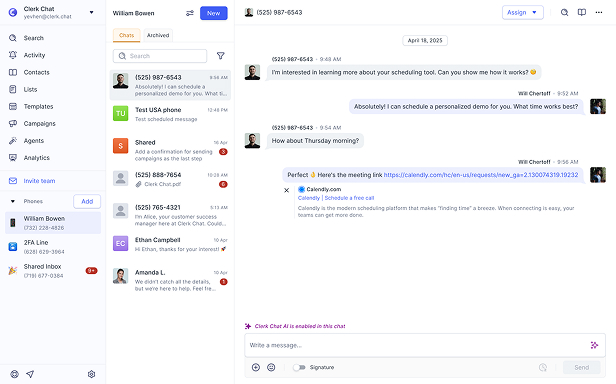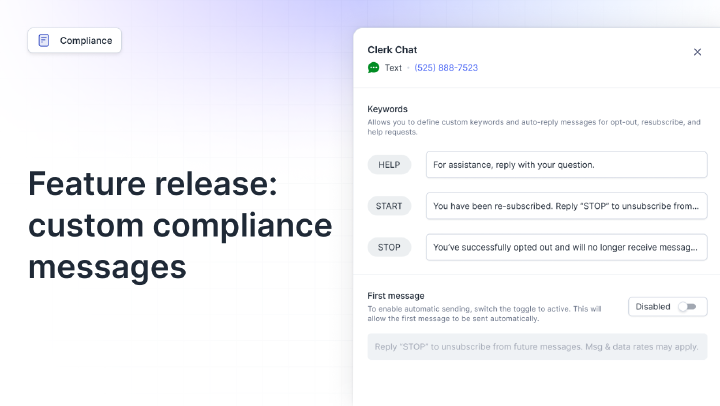When You Should Consider RCS vs MMS for Effective Business Messaging
By Igor Boshoer
- Published: February 14, 2025
RCS vs MMS: What’s the difference?
When most people hear the words “text message,” they think of SMS (Short Messaging Service). After all, SMS is the standard messaging protocol available on all phones (mobile and smartphones) worldwide. But it’s not the only form of messaging available anymore.
As the way we communicate has evolved, the protocols available for messaging have changed too. First, MMS (Multimedia Messaging Service) emerged to give people a way to send “richer” content over cellular networks, like images and videos. After discovering the power of SMS marketing, countless companies adopted MMS to create more “engaging” text campaigns.
Then, RCS (Rich Communication Services) were introduced, offering another way to communicate with more interactive, multimedia messages, using internet protocols rather than carrier connections.
Initially, RCS had limited adoption, due to it only being available through specific carriers and devices. Apple famously didn’t enable RCS on its devices until the most recent iOS 18 update – meaning customers had to choose between iMessage or RCS, depending on their phone.
Now that Apple has adopted RCS too, adoption of this messaging protocol is growing. The question is how does it compare to MMS and SMS, and how do you know which messaging solution you should be using for business communications?
In this article:
Differences Between RCS vs. MMS vs. SMS
Let’s start with a brief overview of the three most “common” messaging protocols available today: SMS vs RCS, vs MMS. SMS is the golden standard – the original messaging protocol available through every mobile device and carrier worldwide.
For companies searching for the best business messaging channels, SMS still offers the broadest reach and accessibility. It also offers access to a few unique features, such as the ability to send mass texts at speed to a wide number of users (with minimal costs).
However, SMS only allows for text-based messaging.
You can’t send images, voice notes, and videos over SMS. That’s where MMS came in. The Multimedia Messaging Service introduced a new opportunity to create longer plain text messages and add various elements like video clips, emojis, and images.
The rise of MMS enabled companies to explore conversational messaging strategies in new ways, creating more immersive and engaging campaigns. Just like SMS, MMS is supported by virtually all carriers and phone manufacturers – and it doesn’t require an internet connection. Instead, messages are sent and received through carrier connections.
RCS on the other hand, is a newer contender that builds on the multimedia capabilities of MMS with extra features, like encryption, and interactive elements (such as read receipts and typing indicators). It takes advantage of Internet Protocols (data connectivity or Wi-Fi), to send messages through web connections, rather than through carrier connections.
While RCS business messages are arguably more feature rich than both SMS and MMS messages, they lack reach – as RCS isn’t supported by all phones and carriers.
Let’s break things down a little further.
Choose the messaging solution that aligns with your business needs and budget.
MMS vs RCS: What is MMS?
MMS, the Multimedia Messaging Service, is a protocol that allows users to send longer text messages than SMS, with more unique elements, like photos, videos, links, or audio clips.
It uses the same technology as SMS, enabling companies and users to send texts to multiple contacts through cellular networks. MMS supports both P2P messaging (person to person) and application to person (A2P messaging) through specialist platforms.
Some of the core features of MMS include:
- Longer messages: MMS messages can contain up to 1,600 characters – a lot more than a standard SMS message, giving it more versatility.
- Media support: With MMS, you can send standard, promotional or transactional text messages that contain images, links, video, and audio clips.
- Cellular Network Transmission: MMS messages are sent through the cellular network, so they don’t rely on an internet connection (unlike RCS).
Ultimately, the biggest benefit of MMS over SMS and RCS is that MMS allows companies to send multimedia messages to a wider range of users, over a cellular network, without the need for data or Wi-Fi. You can reach users anywhere – even if they don’t have an internet connection.
Interactive Demo: Beyond Basic Business Texting
RCS vs MMS: What is RCS?
RCS, or the Rich Communication Service protocol is a messaging protocol developed by GMSA to replace SMS and MMS. It brings a range of advanced features to standard messaging strategies, and leverages internet connections (cellular data or Wi-Fi) to send and receive messages.


Some of the key features of RCS include:
- Rich media support: RCS allows users to create messages that feature high-resolution photos, videos, GIFs, audio files, and other forms of media. You can also add buttons or forms into messages to enable interactivity.
- Typing indicators and read receipts: RCS supports read receipts and typing indicators, so you know exactly when someone receives a message, and when they’re responding.
- Greater scalability: There aren’t any strict character restrictions on RCS messages, and you can create group chats with RCS that feature up to 100 recipients.
- Customization: With RCS marketing strategies, companies can add branded elements with verified sender profiles that showcase logos, and contact details.
- Internet transmission: RCS messages are sent through cellular data or Wi-Fi, rather than relying on cellular networks.
On the one hand, RCS has a lot of benefits. Alongside supporting more rich media, from longer videos and higher-resolution images to MMS, it also provides access to more interactive features, like read receipts and embeddable forms.
Additionally, unlike OTT services like WhatsApp, RCS doesn’t require users to download a separate app. As long as RCS is supported by a carrier and device, anyone can access the messaging protocol through the standard messaging feature on a phone.
However, RCS has its limitations too. For instance, it’s only available from certain carriers and devices, and requires access to the internet. If customers don’t have access to the internet, they could end up not receiving text messages from companies or friends using RCS.
What’s the Difference Between RCS and MMS?
Now that you’ve had SMS, MMS, and rich communication services explained to you, you might still be a little fuzzy on the major differences. After all, MMS and RCS seem pretty similar – as they both support multimedia messaging.
Here’s a simple overview of the key differences, side-by-side:
| Feature | RCS | MMS |
|---|---|---|
| Media support | High-resolution images, videos, forms, buttons, GIFs, audio clips, and a wide range of other file types (supported without the need for compression) | Basic support for images, emojis, audio, and video, but with strict size limitations that may affect quality |
| Message length | No strict character limits | Up to 1,600 characters |
| Group/Mass messaging | Advanced support for group messaging with up to 100 users | Basic group messaging features, but better mass texting capabilities with the right business messaging software or platform |
| Interactive features | Carousels, suggested replies, buttons, rich cards, location tracking, read receipts, and typing indicators | Limited interactive components |
| Deliverability | Requires an internet connection – Wi-Fi or cellular data | Relies on cellular networks and doesn’t require internet access |
| Customization options | Extensive customization options with verified sender profiles | Limited customization options without access to a business messaging platform |
| Security | End-to-end encryption available from some carriers and vendors | No end-to-end encryption |
| File sharing | Supported for up to 100MB files | Supported for files of around 1-3MB in most cases |
| Accessibility | Available from some carriers and device vendors | Available on virtually all phones |
RCS vs MMS Message: Which is Better for Businesses?
So in the battle of RCS vs MMS, which is better for businesses? At a glance, you might assume that RCS is the better option, as it allows you to create richer, more interactive messaging campaigns. While you can still create personalized text messages with MMS, RCS allows you to add more rich media and interactive components like forms and buttons.
However, MMS is also more accessible, and has much better reach. Not only is it available on most devices, and supported by virtually every carrier, but it eliminates the need for an internet connection.
Choose the messaging solution that aligns with your business needs and budget.
When to Consider RCS
When choosing between MMS vs RCS, the latter option is usually a good choice for campaigns that require a lot of interactive and unique elements. If you’re leveraging conversational AI for customer service, sales and messaging and want your bots to include unique elements in a message, or you want to add images and videos to promotional messages, RCS is a good choice.
You can use RCS to send promotional messages, like flash sale messages or abandoned cart reminders that include a button to make a purchase, or an image of the product. You could send transactional messages that include maps for tracking deliveries, or customer-service based messages that include tutorial videos.
You can even embed things like mobile tickets or calendar information into RCS messages used when you’re sending customers event reminders. RCS is great when:
- Visual appeal is crucial: With the ability to add more high-resolution photos and videos into your messages, RCS is great for making your messages more aesthetically pleasing.
- Custom branding is essential: With RCS business messaging, you can create verified sender profiles that enhance your messaging with specific logos and color palettes.
- Interactivity is valuable: If you want to add interactive elements like buttons and forms to your messages, RCS is the best option.
When to Consider MMS
So, when does MMS win the RCS vs MMS debate? Simply put, MMS is better for companies that value scale and reliability. With MMS, you can engage in conversational SMS strategies, two-way interactions, and send marketing messages without worrying about deliverability.
MMS is supported by most carriers and phones, and it doesn’t require your user to have an internet connection to read your messages.
Just like RCS, you can use MMS to send marketing messages that feature images of a products, or short video clips. You’ll be able to distribute informational messages like order update alerts and notifications with rich media. Plus, you can leverage convenient two-way text messaging features for customer service conversations.
MMS is the best option when:
- Wide reach is crucial: MMS is supported by virtually all mobile phone carriers – particularly those in the US. It doesn’t require an internet connection, or any special features on a phone, meaning you can reach a wider audience.
- Simplicity is essential: If you’re sending simple messages using automated text messaging solutions – such as texts about order updates, MMS will be more than enough. You don’t necessarily need the advanced features of RCS for every message.
- Automation is valuable: Although you can automate RCS conversations with innovative software, there are more platforms out there that support automation for MMS marketing campaigns and customer service conversations.
Will RCS Replace SMS and MMS?
RCS is a valuable tool for business messaging. In all industries, RCS offers companies an opportunity to connect with customers with messages that feature more media and interactive elements. It can even be a more secure option compared to SMS and MMS, thanks to embedded encryption options.
Unfortunately, RCS still has limitations. Although around 1 billion people have access to the messaging protocol today, there are still various vendors and carriers that don’t support RCS worldwide. If you’ve ever wondered why text messages fail to send through RCS – it could be that the device or carrier the customer is using doesn’t support the protocol.
Plus, RCS is excellent for group messaging, but it’s still not the perfect option for mass messaging – particularly when you want to send a lot of transactional messages or alerts to thousands of customers at once. Even the RCS Business Messaging service has limitations for mass communication.
On top of that, while RCS has better security capabilities (such as support for encryption), the level of encryption available will depend on the device and carrier in use. You’ll also still need to follow SMS compliance standards, and adhe re to guidelines on how you send promotional and sales-based messages to customers.
Ultimately, while RCS is valuable, it’s unlikely to overtake SMS or MMS completely. In fact, RCS still relies on SMS as a “fallback” for sending messages to contacts when an internet connection isn’t available.
RCS vs MMS? Why Not Both?
In the battle of MMS vs RCS, both messaging options have their strengths and limitations. They also have a lot of similarities. Both allow for texting from a computer, and support multimedia capabilities. However, they serve very different use cases.
RCS is ideal when you want to create highly engaging text campaigns that include rich media and interactive elements – but with these messages, you’ll only be able to reach a segment of your audience. MMS has limitations in terms of the unique features you can access, but it gives you a lot more reach and reliability.
Ultimately, the best way to make sure you’re developing the right business messaging strategy – is to embrace both options. With a platform like Clerk Chat, companies can access SMS, MMS, RCS, and other OTT messaging solutions like WhatsApp, all in the same platform.
They can leverage any messaging strategy they choose whether they’re sending promotional messages to customers, using text message auto-reply features to respond to queries, or distributing alerts.
Plus, with Clerk Chat, you also get advanced features like conversational AI bots, advanced reporting and analytics, dynamic cohorts for audience segmentation and more.
Take the holistic approach to business messaging, with Clerk Chat.
An innovator by nature, Igor is dedicated to translating the technical aspects of product development into actionable business strategies and sales growth. He thrives when building scalable infrastructures while leading global teams to success. In his free time he indulges in his passions for film, mathematics, and engineering. Find his tech expertise in films like The Wolf of Wall Street.
In this article:
Ready to use your business number for text messaging?
Thousands of businesses are already experiencing the power of conversational messaging through SMS. Join us. Free trial and paid tiers available.
Get Started#Subscribe
Get product updates in your inbox
Tutorials, features, and Clerk Chat news delivered straight to you.




